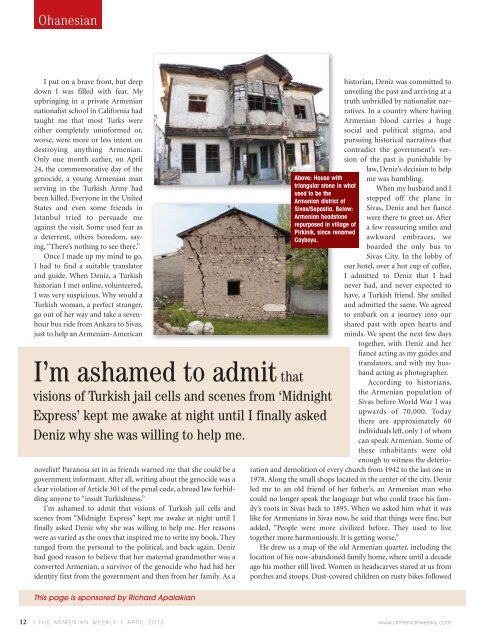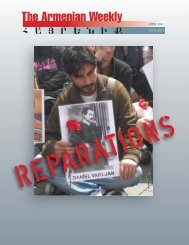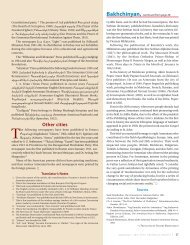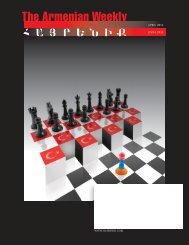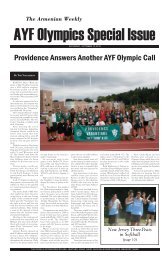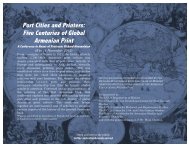You also want an ePaper? Increase the reach of your titles
YUMPU automatically turns print PDFs into web optimized ePapers that Google loves.
Ohanesian<br />
I put on a brave front, but deep<br />
down I was filled with fear. My<br />
upbringing in a private <strong>Armenian</strong><br />
nationalist school in California had<br />
taught me that most Turks were<br />
either completely uninformed or,<br />
worse, were more or less intent on<br />
destroying anything <strong>Armenian</strong>.<br />
Only one month earlier, on April<br />
24, the commemorative day of the<br />
genocide, a young <strong>Armenian</strong> man<br />
serving in the Turkish Army had<br />
been killed. Everyone in the United<br />
States and even some friends in<br />
Istanbul tried to persuade me<br />
against the visit. Some used fear as<br />
a deterrent, others boredom, saying,<br />
“T<strong>here</strong>’s nothing to see t<strong>here</strong>.”<br />
Once I made up my mind to go,<br />
I had to find a suitable translator<br />
and guide. When Deniz, a Turkish<br />
historian I met online, volunteered,<br />
I was very suspicious. Why would a<br />
Turkish woman, a perfect stranger,<br />
go out of her way and take a sevenhour<br />
bus ride from Ankara to Sivas,<br />
just to help an <strong>Armenian</strong>-American<br />
novelist? Paranoia set in as friends warned me that she could be a<br />
government informant. After all, writing about the genocide was a<br />
clear violation of Article 301 of the penal code, a broad law forbidding<br />
anyone to “insult Turkishness.”<br />
I’m ashamed to admit that visions of Turkish jail cells and<br />
scenes from “Midnight Express” kept me awake at night until I<br />
finally asked Deniz why she was willing to help me. Her reasons<br />
were as varied as the ones that inspired me to write my book. They<br />
ranged from the personal to the political, and back again. Deniz<br />
had good reason to believe that her maternal grandmother was a<br />
converted <strong>Armenian</strong>, a survivor of the genocide who had hid her<br />
identity first from the government and then from her family. As a<br />
Above: House with<br />
triangular stone in what<br />
used to be the<br />
<strong>Armenian</strong> district of<br />
Sivas/Sepastia. Below:<br />
<strong>Armenian</strong> headstone<br />
repurposed in village of<br />
Pirkinik, since renamed<br />
Cayboyu.<br />
I’m ashamed to admit that<br />
visions of Turkish jail cells and scenes from ‘Midnight<br />
Express’ kept me awake at night until I finally asked<br />
Deniz why she was willing to help me.<br />
historian, Deniz was committed to<br />
unveiling the past and arriving at a<br />
truth unbridled by nationalist narratives.<br />
In a country w<strong>here</strong> having<br />
<strong>Armenian</strong> blood carries a huge<br />
social and political stigma, and<br />
pursuing historical narratives that<br />
contradict the government’s version<br />
of the past is punishable by<br />
law, Deniz’s decision to help<br />
me was humbling.<br />
When my husband and I<br />
stepped off the plane in<br />
Sivas, Deniz and her fiancé<br />
were t<strong>here</strong> to greet us. After<br />
a few reassuring smiles and<br />
awkward embraces, we<br />
boarded the only bus to<br />
Sivas City. In the lobby of<br />
our hotel, over a hot cup of coffee,<br />
I admitted to Deniz that I had<br />
never had, and never expected to<br />
have, a Turkish friend. She smiled<br />
and admitted the same. We agreed<br />
to embark on a journey into our<br />
shared past with open hearts and<br />
minds. We spent the next few days<br />
together, with Deniz and her<br />
fiancé acting as my guides and<br />
translators, and with my husband<br />
acting as photographer.<br />
According to historians,<br />
the <strong>Armenian</strong> population of<br />
Sivas before World War I was<br />
upwards of 70,000. Today<br />
t<strong>here</strong> are approximately 60<br />
individuals left, only 1 of whom<br />
can speak <strong>Armenian</strong>. Some of<br />
these inhabitants were old<br />
enough to witness the deterioration<br />
and demolition of every church from 1942 to the last one in<br />
1978. Along the small shops located in the center of the city, Deniz<br />
led me to an old friend of her father’s, an <strong>Armenian</strong> man who<br />
could no longer speak the language but who could trace his family’s<br />
roots in Sivas back to 1895. When we asked him what it was<br />
like for <strong>Armenian</strong>s in Sivas now, he said that things were fine, but<br />
added, “People were more civilized before. They used to live<br />
together more harmoniously. It is getting worse.”<br />
He drew us a map of the old <strong>Armenian</strong> quarter, including the<br />
location of his now-abandoned family home, w<strong>here</strong> until a decade<br />
ago his mother still lived. Women in headscarves stared at us from<br />
porches and stoops. Dust-covered children on rusty bikes followed<br />
This page is sponsored by Richard Apalakian<br />
12<br />
| THE ARMENIAN WEEKLY | APRIL 2013<br />
www.armenianweekly.com


